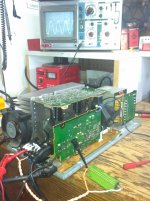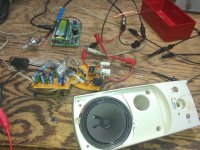I'm playing with a Panasonic subwoofer amp I found on someone's curb...has six amps inside, 1000W total. Figured out the 25-pin connector, and want to use it as a spare power amp in my son's garage band.....
Have confirmed all six amps work (stereo front & rear, center & sub), and get "rated" power from each. For ex: center chl puts out 95Vp-p and 4.0A, before clipping. Allowing for scope probe impedance error and DMM reading a 1KHz signal, E x I x 0.707 = 270W (matches factory manual). For whatever that's worth....
Of course, each amp needs a preamp, and I will be putting everything from a guitar to a keyboard to a mixing board into these amps. The preamp I'm testing is from an old set of PC speakers (are you getting the idea this is low budget....?), which boosts a guitar sufficiently, as well as an MP3 player (when it's gain is lowered considerably - yes, two very different inputs!). I NEED to keep the preamp from clipping, and teenagers will be operating this.....
So I thought about an LED clip indicator - like a fuzz box I built once.... when the LED clips it lights up! Determine the proper series resistor to not let it clip until just before the preamp does, and voila??? Anyone done anything like this?
I need ingenuity/simplicity, not "just buy a stereo compressor-limiter...." Thanks!
Have confirmed all six amps work (stereo front & rear, center & sub), and get "rated" power from each. For ex: center chl puts out 95Vp-p and 4.0A, before clipping. Allowing for scope probe impedance error and DMM reading a 1KHz signal, E x I x 0.707 = 270W (matches factory manual). For whatever that's worth....
Of course, each amp needs a preamp, and I will be putting everything from a guitar to a keyboard to a mixing board into these amps. The preamp I'm testing is from an old set of PC speakers (are you getting the idea this is low budget....?), which boosts a guitar sufficiently, as well as an MP3 player (when it's gain is lowered considerably - yes, two very different inputs!). I NEED to keep the preamp from clipping, and teenagers will be operating this.....
So I thought about an LED clip indicator - like a fuzz box I built once.... when the LED clips it lights up! Determine the proper series resistor to not let it clip until just before the preamp does, and voila??? Anyone done anything like this?
I need ingenuity/simplicity, not "just buy a stereo compressor-limiter...." Thanks!
Attachments
Dave Jones nails it with this one.
https://www.youtube.com/watch?v=b4Zh-RYRUq4
But I know how teenage garage bands go and it turns into "volume wars" in a hot minute. Might I suggest putting a limit on the gain that the preamp feeds the amp with so that even when it's all the way up there is no danger to equipment.
https://www.youtube.com/watch?v=b4Zh-RYRUq4
But I know how teenage garage bands go and it turns into "volume wars" in a hot minute. Might I suggest putting a limit on the gain that the preamp feeds the amp with so that even when it's all the way up there is no danger to equipment.
Good idea, but since the preamp gain is dependant on the input level into it (varying from guitar to line level), and the preamp does have a vol pot, I need something that clamps the output regardless of vol setting, without clipping (cause I don't think power amps like square waves, or would that be OK?)
It's always going to be line level into the amp right? Plugging a guitar direct into an amp like you have sounds terrible. It's at least going to be coming out of a distortion pedal right?
I'd figure on controlling the line level input and if the bass player needs more gain because he's trying to just plug right into the amp, he's gonna have to invest in a compressor pedal or an EQ pedal or something like that for 60-100 bucks. It'll sound way better anyway.
Then if they try to turn up their stuff to loud it'll just overdrive the preamp (sounding awful) and the amp part will be fine.
I'd figure on controlling the line level input and if the bass player needs more gain because he's trying to just plug right into the amp, he's gonna have to invest in a compressor pedal or an EQ pedal or something like that for 60-100 bucks. It'll sound way better anyway.
Then if they try to turn up their stuff to loud it'll just overdrive the preamp (sounding awful) and the amp part will be fine.
Have confirmed all six amps work (stereo front & rear, center & sub), and get "rated" power from each. For ex: center chl puts out 95Vp-p and 4.0A, before clipping. Allowing for scope probe impedance error and DMM reading a 1KHz signal, E x I x 0.707 = 270W (matches factory manual). For whatever that's worth....
That sounds FAR better than most such amps, the power figures are usually completely imaginary - although it all depends on how good the PSU is, and it's unlikely to be able to survive being driven hard (instrument and PA amps have to be a LOT better made than home audio ones.).
I'm also a little concerned how you measured the output current 😱 it's not something that is normally done, there's no point in it - just measure the output voltage feeding a dummy load, convert to RMS, square it, and divide by the load impedance.
I will check power using voltage across the 8.2ohm dummy...done it before...I put a Fluke mdl 77 in series with spkr, set to 10A range, for current. Your method is easier! Thanks.
Looking at the picture the mains transformer seems to be far too small for the claimed output? - which is one reason they aren't very good for instrument amps.
I agree, but for sound reinforcment for a some.teenagers in a back yard, and come compression I think it might do. Want to keep costs down as well.... Thanks!
Most rock bands will overdrive their amps, for distortion effect if not just straight out loudness wars. A guitar needs to see a 1Meg ohm amp input impedance, or will lose it's high treble and sound horrible. Plugging a guitar right into a conventional poweramp or hi-fi preamp would present way too low of an impedance/load for the guitar. Some sort of guitar preamp is mandatory because of this.
Clipping with the reactive load of a speaker is hard on most amps. Phase margin gets bitch-slapped left and right. I'd put a 1 ohm resistor in series with the final output, as protection for the stability of the amp, so when it gets jammed into clipping on a regular basis its challenge will be limited. That will throw away maybe roughly 10% of the power (so use a big wattage rating R), but the amp will be less likely to blow up and blow the speakers as well. The 1 ohm resistor may actually improve the sound by lessening damping of the speaker cone. It may have a more relaxed sound, closer to tube sound.
Clipping with the reactive load of a speaker is hard on most amps. Phase margin gets bitch-slapped left and right. I'd put a 1 ohm resistor in series with the final output, as protection for the stability of the amp, so when it gets jammed into clipping on a regular basis its challenge will be limited. That will throw away maybe roughly 10% of the power (so use a big wattage rating R), but the amp will be less likely to blow up and blow the speakers as well. The 1 ohm resistor may actually improve the sound by lessening damping of the speaker cone. It may have a more relaxed sound, closer to tube sound.
- Status
- Not open for further replies.
- Home
- Live Sound
- Instruments and Amps
- Home theatre subwoofer amp project

